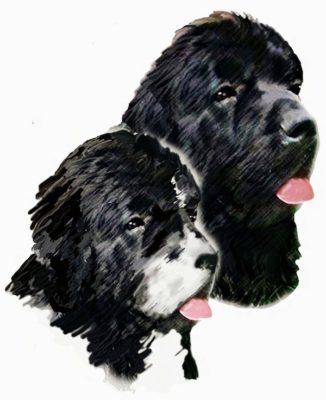
It’s a surprising theory, if not debatable, that original Newfoundlands were not solid black. Or solid anything.
Because there was little effort put into recording the breeding of dogs before the Victorian era, the conjecture is based on old artwork, monographs, and “lost and found” classified ads that appeared in the Times newspaper. The hypothesis appeared as an abstract in the Open Veterinary Journal back in 2015.
One of the old monographs mentioned in the abstract put forward the “fact” that white and black spotted Newfoundland dogs were popular for a time back in the 1820s and 1830s, but only after being portrayed by Sir Edwin Landseer, an influential artist with a particular liking for the dogs. From the 1880s on, the black and white dogs came to be known as “Landseer Newfoundlands,” so coined by the eccentric Victorian dog fancier, Dr. William Gordon Stables. If solid black dogs were common in Landseer’s time, it is thought to be highly unlikely that the artist wouldn’t be able to paint one, the tacit suggestion being that they weren’t common.
In the aforementioned abstract by J. Bondeson from the Department of Rheumatology, School of Medicine at Cardiff University, the author proposes that most Newfs at the time were similar to the dog mentioned in the following notice from 1785: “LOST on Saturday last, May 28th, a large Black Newfoundland Dog, has White Feet, a little White in the Forehead, the end of his Tail White, answers to the Name of Lyon.”
Bondeson’s abstract included a review of of 134 similar such advertisements seeking to recover lost or stolen Newfoundland dogs from 1785 until 1890. With a couple of exclusions, the remaining 132 dogs in the adverts were described to be in color patterns recognized today. Before 1840, there wasn’t a single advertisement describing a solid black or brown Newfoundland, and 15 dogs were obviously white and black, or white and brown. Between 1840 and 1850, however, solid black dogs begin appearing in the Times advertisements, and between 1850-1859, they were nearly as frequently described as the other coat color variations. Between 1860-1890, solid black dogs were now in the majority. Bondeson’s conclusion: Though it would eventually become the most common color for the breed, solid black Newfoundlands were scarce in Britain before to 1840 suggesting to the author that the ‘solid’ gene was introduced into the British population of Newfoundlands in the 1840s.
The abstract makes for interesting reading, particularly to Newfoundland fanciers, and for those with a liking for genetics. You can read Boneson’s paper, Historical analysis of Newfoundland Dog Fur Colour Genetics, here.

Wasn’t the Lewis and Clark dog, Seaman, Black.
We’ve read varying information, Carol. Nowhere in any of the explorers’ original manuscript journals is the color of Seamen given, but in the early 1800s, dogs called the “Newfoundland” were basically white with dark markings. A Newfoundland Club of America article written by Emma H. Mellencamp, PhD., describes early paintings of Newfoundland dogs or Newfoundland-type dogs as being basically white, and the detail on a display sign at Waterfront Trail, Stevenson, Washington shows a mostly white Newfoundland. Accounts of Seamen being black have, as far as we can tell, appeared in fictionalized portrayals of Lewis and Clark. Not sure we’ll ever really know with certainty…